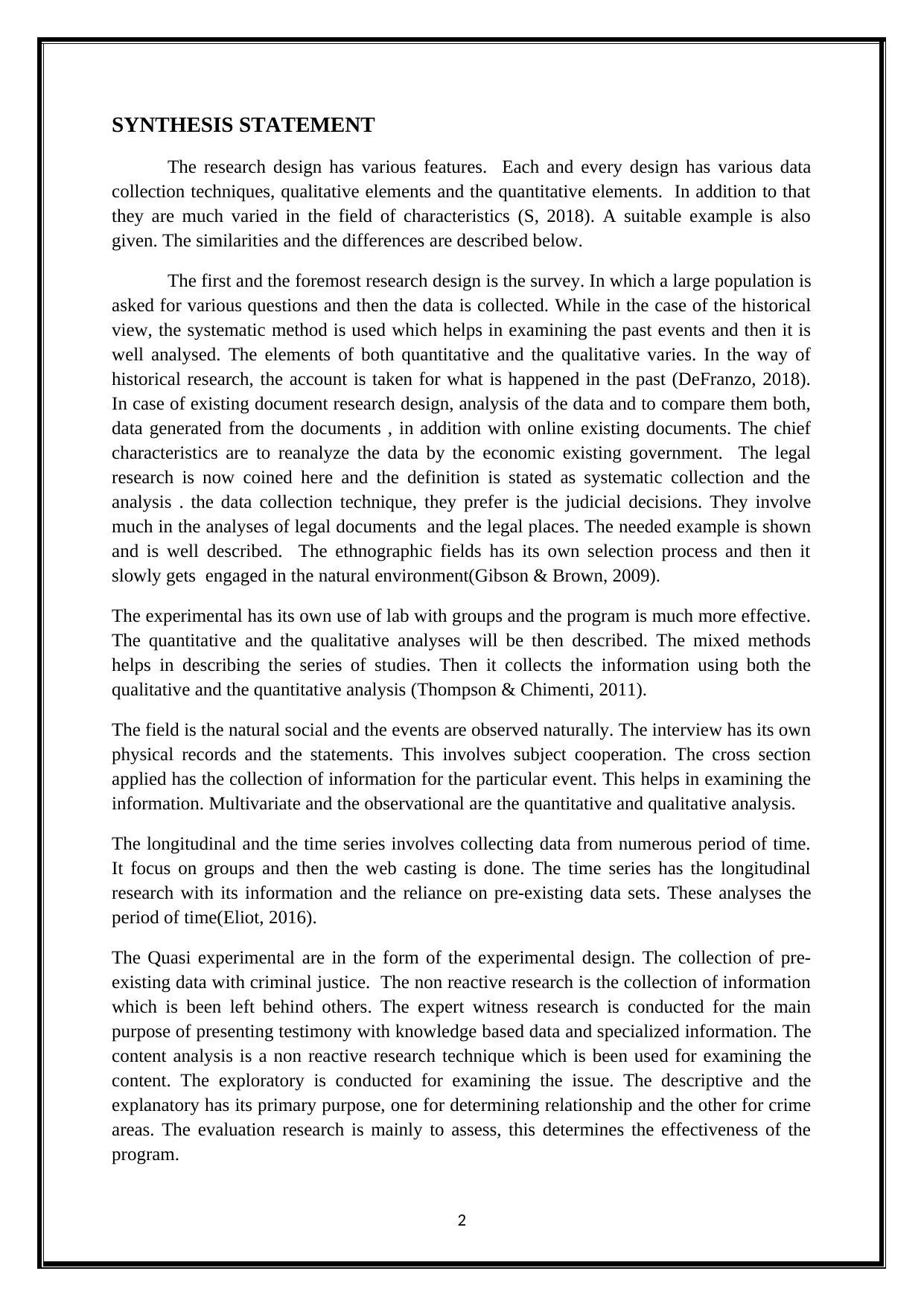A Comparative Analysis of Various Research Design Methodologies
VerifiedAdded on 2021/04/24
|3
|712
|82
Homework Assignment
AI Summary
This assignment provides a synthesis statement comparing various research designs, including surveys, historical research, existing document analysis, legal research, ethnographic fields, experimental designs, and mixed methods. It details the data collection techniques, qualitative and quantitat...

Paraphrase This Document
Need a fresh take? Get an instant paraphrase of this document with our AI Paraphraser

SYNTHESIS STATEMENT
The research design has various features. Each and every design has various data
collection techniques, qualitative elements and the quantitative elements. In addition to that
they are much varied in the field of characteristics (S, 2018). A suitable example is also
given. The similarities and the differences are described below.
The first and the foremost research design is the survey. In which a large population is
asked for various questions and then the data is collected. While in the case of the historical
view, the systematic method is used which helps in examining the past events and then it is
well analysed. The elements of both quantitative and the qualitative varies. In the way of
historical research, the account is taken for what is happened in the past (DeFranzo, 2018).
In case of existing document research design, analysis of the data and to compare them both,
data generated from the documents , in addition with online existing documents. The chief
characteristics are to reanalyze the data by the economic existing government. The legal
research is now coined here and the definition is stated as systematic collection and the
analysis . the data collection technique, they prefer is the judicial decisions. They involve
much in the analyses of legal documents and the legal places. The needed example is shown
and is well described. The ethnographic fields has its own selection process and then it
slowly gets engaged in the natural environment(Gibson & Brown, 2009).
The experimental has its own use of lab with groups and the program is much more effective.
The quantitative and the qualitative analyses will be then described. The mixed methods
helps in describing the series of studies. Then it collects the information using both the
qualitative and the quantitative analysis (Thompson & Chimenti, 2011).
The field is the natural social and the events are observed naturally. The interview has its own
physical records and the statements. This involves subject cooperation. The cross section
applied has the collection of information for the particular event. This helps in examining the
information. Multivariate and the observational are the quantitative and qualitative analysis.
The longitudinal and the time series involves collecting data from numerous period of time.
It focus on groups and then the web casting is done. The time series has the longitudinal
research with its information and the reliance on pre-existing data sets. These analyses the
period of time(Eliot, 2016).
The Quasi experimental are in the form of the experimental design. The collection of pre-
existing data with criminal justice. The non reactive research is the collection of information
which is been left behind others. The expert witness research is conducted for the main
purpose of presenting testimony with knowledge based data and specialized information. The
content analysis is a non reactive research technique which is been used for examining the
content. The exploratory is conducted for examining the issue. The descriptive and the
explanatory has its primary purpose, one for determining relationship and the other for crime
areas. The evaluation research is mainly to assess, this determines the effectiveness of the
program.
2
The research design has various features. Each and every design has various data
collection techniques, qualitative elements and the quantitative elements. In addition to that
they are much varied in the field of characteristics (S, 2018). A suitable example is also
given. The similarities and the differences are described below.
The first and the foremost research design is the survey. In which a large population is
asked for various questions and then the data is collected. While in the case of the historical
view, the systematic method is used which helps in examining the past events and then it is
well analysed. The elements of both quantitative and the qualitative varies. In the way of
historical research, the account is taken for what is happened in the past (DeFranzo, 2018).
In case of existing document research design, analysis of the data and to compare them both,
data generated from the documents , in addition with online existing documents. The chief
characteristics are to reanalyze the data by the economic existing government. The legal
research is now coined here and the definition is stated as systematic collection and the
analysis . the data collection technique, they prefer is the judicial decisions. They involve
much in the analyses of legal documents and the legal places. The needed example is shown
and is well described. The ethnographic fields has its own selection process and then it
slowly gets engaged in the natural environment(Gibson & Brown, 2009).
The experimental has its own use of lab with groups and the program is much more effective.
The quantitative and the qualitative analyses will be then described. The mixed methods
helps in describing the series of studies. Then it collects the information using both the
qualitative and the quantitative analysis (Thompson & Chimenti, 2011).
The field is the natural social and the events are observed naturally. The interview has its own
physical records and the statements. This involves subject cooperation. The cross section
applied has the collection of information for the particular event. This helps in examining the
information. Multivariate and the observational are the quantitative and qualitative analysis.
The longitudinal and the time series involves collecting data from numerous period of time.
It focus on groups and then the web casting is done. The time series has the longitudinal
research with its information and the reliance on pre-existing data sets. These analyses the
period of time(Eliot, 2016).
The Quasi experimental are in the form of the experimental design. The collection of pre-
existing data with criminal justice. The non reactive research is the collection of information
which is been left behind others. The expert witness research is conducted for the main
purpose of presenting testimony with knowledge based data and specialized information. The
content analysis is a non reactive research technique which is been used for examining the
content. The exploratory is conducted for examining the issue. The descriptive and the
explanatory has its primary purpose, one for determining relationship and the other for crime
areas. The evaluation research is mainly to assess, this determines the effectiveness of the
program.
2

References
DeFranzo, S. (2018). Difference between qualitative and quantitative research.. Snap Surveys
Blog. Retrieved 30 March 2018, from https://www.snapsurveys.com/blog/qualitative-vs-
quantitative-research/
Eliot, G. (2016). The mill on the Floss. New York: Open Road Integrated Media.
Gibson, W., & Brown, A. (2009). Working with qualitative data. London: SAGE.
S, S. (2018). Difference Between Qualitative and Quantitative Research (With Comparison
Chart) - Key Differences. Key Differences. Retrieved 30 March 2018, from
https://keydifferences.com/difference-between-qualitative-and-quantitative-
research.html
Thompson, D., & Chimenti, D. (2011). Review of progress in quantitative nondestructive
evaluation. Meville, N.Y.: American Institute of Physics.
3
DeFranzo, S. (2018). Difference between qualitative and quantitative research.. Snap Surveys
Blog. Retrieved 30 March 2018, from https://www.snapsurveys.com/blog/qualitative-vs-
quantitative-research/
Eliot, G. (2016). The mill on the Floss. New York: Open Road Integrated Media.
Gibson, W., & Brown, A. (2009). Working with qualitative data. London: SAGE.
S, S. (2018). Difference Between Qualitative and Quantitative Research (With Comparison
Chart) - Key Differences. Key Differences. Retrieved 30 March 2018, from
https://keydifferences.com/difference-between-qualitative-and-quantitative-
research.html
Thompson, D., & Chimenti, D. (2011). Review of progress in quantitative nondestructive
evaluation. Meville, N.Y.: American Institute of Physics.
3
⊘ This is a preview!⊘
Do you want full access?
Subscribe today to unlock all pages.

Trusted by 1+ million students worldwide
1 out of 3
Related Documents
Your All-in-One AI-Powered Toolkit for Academic Success.
+13062052269
info@desklib.com
Available 24*7 on WhatsApp / Email
![[object Object]](/_next/static/media/star-bottom.7253800d.svg)
Unlock your academic potential
© 2024 | Zucol Services PVT LTD | All rights reserved.



